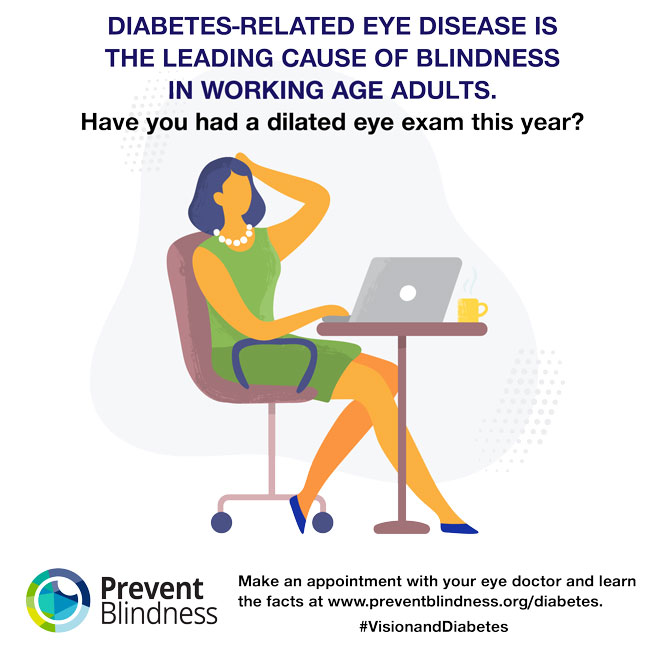
Chances are you know someone who is diabetic, or you are yourself. More than 30 million people in the United States have diabetes. One in four do not know they have diabetes. Diabetes is more common among certain populations such as African Americans, Hispanics, American Indians, Asian Americans and
Pacific Islanders.
You are more likely to have diabetes if you are:
- 45 or older
- have a family history of the disease
- high blood pressure
- have excess weight
The good news is that you can manage diabetes by taking good care of yourself through healthy meal planning, regular exercise, and taking medication as prescribed.
If you have diabetes, prevention of diabetic-related eye diseases is a priority. Diabetes-related eye disease can cause you to have trouble reading, seeing faces across the room, seeing at night, or even blindness.
The good news is that diabetes-related eye disease can often be prevented or managed with a healthy lifestyle and annual visits to an eye doctor.
Diabetic Retinopathy is very common :
Diabetic Retinopathy is one of the leading causes of blindness in adults. It results when high blood sugar damages the blood vessels in the retina, causing them to swell and leak, causing blurry vision. New, abnormal blood vessels can also grow and create additional visual problems. Diabetic retinopathy often affects both eyes.
Diabetic retinopathy can develop in persons with ay type of diabetes, and the longer you’ve had diabetes, the more likely you are to develop it. Additional risk factors include high blood sugar, high blood pressure, high cholesterol, smoking, and being from certain ethnicities (African American, Hispanic/Latinos, American Indian/Alaska natives).
Be sure to call your eye doctor if you notice any changes in your vision, especially if they occur suddenly. Notable changes might include blurring, spots, flashes, blind spots, difficulty reading or doing detail work, distortion.
Diabetic retinopathy has two stages of development:
The early stage, called non-proliferative, occurs when the retinal blood vessels weaken and bulge, forming pouches that can leak blood and other fluid, causing the macula to swell (macular edema) and vision distortion. Macular edema develops in about 50% of people with diabetic retinopathy.
The late stage, called proliferative, is when the retina begins to grow new blood vessels, which are fragile and can bleed into the vitreous (clear gel between the lens and retina). With minor bleeding, one might see a few dark spots floating in their vision, but if there is a lot of bleeding, vision may be completely blocked.
Symptoms of the later stage may include blurry vision, trouble seeing colors, vision loss, dark or empty areas of vision, spots or dark shapes in vision (floaters).
Be sure to call your eye doctor if you notice any changes in your vision, especially if they occur suddenly. Notable changes might include blurring, spots, flashes, blind spots, difficulty reading or doing detail work, distortion.
Diabetic-related Cataracts
A cataract occurs when the lens of the eye, which is normally clear, becomes cloudy. It’s normal to experience some clouding of the lens as we get older, but people with diabetes are more likely to develop cataracts, and often at a younger age. High blood sugar can cause deposits to build up in the lenses
Risk factors for cataracts include excessive sun exposure over time, smoking, high blood pressure, and having obesity. The only treatment for cataracts is surgery, but sometimes it is not immediately necessary. Using brighter lighting and appropriate sunglasses can help, but if these interventions are not enough to prevent cataracts from impacting daily living, then it may be time for surgery.
Diabetic-related Glaucoma
Glaucoma is another set of eye disease that can result from diabetes. Glaucoma occurs when there is damage to the optic nerve typically due to excessive pressure in the eye. There are some types of glaucoma that don’t have symptoms and the loss of vision can occur very slowly so that it’s almost unnoticeable.
With diabetes, a person is twice as likely to develop open-angle glaucoma, which is the most common type. Additional risk factors include having a family history of glaucoma, being over age 60, and being of African American, Asian, or Hispanic/Latino ethnicity.
Another type of glaucoma-related to diabetes is neovascular glaucoma, which can sometimes happen with diabetic retinopathy and creates new and abnormal blood vessels growing on the iris (colored part of the eye). The new vessels can block off fluid movement out of the eye and raise the pressure inside.
While glaucoma can’t be prevented, early detection and treatment can help it from getting worse. Treatment options include the use of medicine, laser treatment, and surgery.
Remember, diabetes-related eye disease can often be prevented or managed with a healthy lifestyle and annual visits to an eye doctor.
Citation: www.cdc.gov/diabetes/managing/diabetes-vision-loss.html













